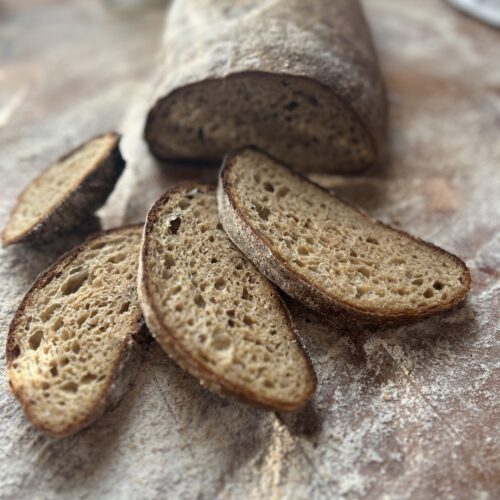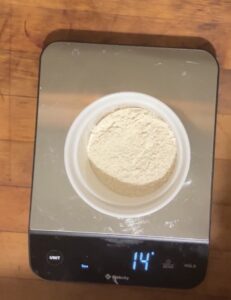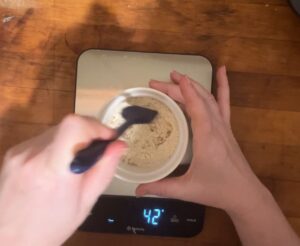
High Hydration Rustic Italian Bread with Whole Wheat Flour
Higher hydration rustic Italian bread, for bigger holes made with whole wheat. This is wet enough to develop gluten with wire whips, or using highest speed roller and scraper on the ank.
Ingredients
- 420 g wheat berries, soft white 100 g soft white, 100 g hard red, 100 g hard white, 60 g durum, 60 g Einkhorn
- 30 g vital wheat gluten You can leave this out or substitute 40g sourdough starter. If so, decrease the water from 500 to 440 g. Your bread won't have the same crumb.
- 400 g water
- 50 g water, boiling
- 11 g sea salt, celtic grey
- 10 g barley malt syrup sugar, honey, or maple syrup can be used, or leave it out for a great bread without sugar
- 10 g yeast (instant) I used instant, active dry can work just prove it first with some of the water
Instructions
- Mill the flour
Prepare Yudane
- Place a small cup on your scale, adding 25 g of flour to it.

- Zero out the scale, and pour 50 g of BOILING water into the bowl.

- Quickly mix into a paste, and set aside.

Mixing the dough
- Add water, yudane, salt, barley malt syrup to your mixing bowl using wire whisks.
- Turn mixer on low speed, and slowly pour in the flour until incorporated.
- Kick up the speed of your mixer to highest setting for about five minutes. The dough will change in consistency from a wet batter to dough that starts to grab on and stretch in the bowl. The sound will also change. Once this happens, turn it off.
- Switch to the dough hook or roller and scraper for the Ankarsrum mixer. Sprinkle in your yeast, and knead the dough by mixer or by hand for about 2 more minutes. The dough is still wet enough that you can do it on a higher speed but it's not necessary.
Fermentation (and stretch and folds)
- Place your dough into an oiled bowl with room to double in size.
- Grab dough on the the 12 o'clock side of the bowl, stretching it up, and pulling it to the other side.
- Turn the bowl by 1/4 turn, and repeat 7 more times.
- Let the 30 dough rest for 30 minutes or until doubled.
Shaping
- Preheat your oven to 450 F. If using a dutch oven, put it into the oven (the bottom only).
- If doing an open bake, shape on a floured surface how Monique does it at Lovely Bell Bakes, or transfer to a banneton basket for a fridge proofing. If baking in a dutch oven, let your dough rise in the same bowl, doing one more set of stretch and folds. I recommend letting the dough do this second rise in the FRIDGE for best results, covered.
- Open bake: Once oven has preheated, your dough should be risen and bubbly. Use a peel or parchment to carefully get it onto the baking stone and dust with flour. Score it if you like, and bake with boiling water in a pan below it, spraying the loaf generously with water before closing the oven. Work quickly.Dutch oven: carefully transfer your dough from the proofing bowl to a floured dutch oven. Top the loaf with flour and put the lid on the Dutch oven. Scoring the loaf is optional, but I had best results without scoring.
- Bake at 450 F for 30 minutes
- Remove the pan of boiling water or remove the Dutch oven lid, depending on which you are using, and lower the oven temp to 425 F.
- Bake at 425 for another 15-20 minutes until the crust is to your liking.
- Remove from the oven and Dutch oven, cooling on a wire rack fully before slicing.
- Store in a paper bag, NOT plastic bags or beeswax - they will soften your crust too much. You can also leave this one on the counter, cut side down, if it'll be eaten fast enough.